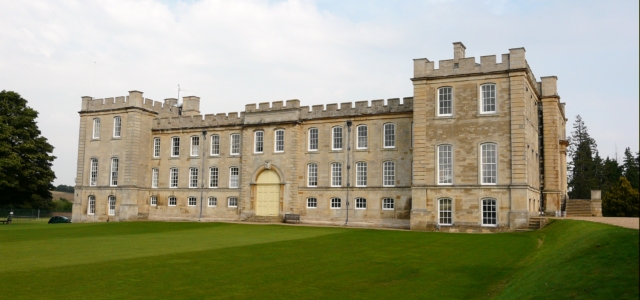
A European Journey #62 – Kimbolton (England)
The German Reformation began with a theological debate that was initiated by an Augustinian monk, Martin Luther. But the English Reformation was triggered by something quite different: a divorce.
After having discovered the Morning Star of the Reformation in our last episode, we will now explore places linked to the Reformation in England.
Today we will visit a small village called Kimbolton. It is located at 100 km North from London, halfway between Northampton and Cambridge. Kimbolton is a small village of a little over a thousand inhabitants. Near the village we find the Grefham waters, one of the biggest water reservoirs of England and one of the largest natural reserves of the area.
But inside the village the main sight is the Kimbolton Castle. This castle, which has served as a school since 1950, was built in the twelfth century by Geoffrey Fitz Peter, the first Earl of Essex, who was a prominent member of the government of England during the reigns of Richard the Lionheart and John Lackland. In 1534, a prominent figure of English mediaeval history came to live here: Catherine of Aragon. She came to live here after having been repudiated by her husband, the king of England Henry VIII.
Strangely enough, the story of her repudiation is at the start of the English Reformation. So let’s explore who this lady was.
Catherine of Aragon was born in the Spanish town of Alcalá de Henares, where incidentally the famous Spanish writer Miguel Cervantes was also born. At the age of 16, Catherine left for the British Isles where she married Arthur Tudor, the prince of Wales and the heir to the English crown. Soon after their marriage, both became ill, and while Catherine recovered, Arthur died.
Seven years after Arthur’s death, his brother Henry wanted to marry her. But there was a problem: the canon law of the Roman Catholic Church forbade such a marriage. The reason was that Rome understood Leviticus 18:16 ‘Thou shalt not uncover the nakedness of thy brother’s wife: it is thy brother’s nakedness’ (KJV), as a ban that was to be enforced whether the brother was alive or dead. But since Catherine was able to prove that her marriage with Arthur was never consummated, Rome approved the marriage.
So, on the 11th of June 1509, Henry and Catherine celebrated their wedding at Greenwich. And twelve days later, Henry was crowned Henry VIII at Westminster Abbey. Their marriage did not seem to be a very happy one, however, mainly because Catherine lost six pregnancies out of seven.
Her only child that survived was a daughter named Mary, but she was a disappointment to her father, because he believed that he needed a boy to take the throne after him. So when Catherine became too old to bear children, Henry resolved to marry another woman that he had begun to court, Anne Boleyn. Henry thus asked the Pope to annul his marriage with Catherine upon the claim that she had, in fact, consummated her marriage with his brother.
This request of divorce was a serious problem for the Pope. At the time, the Roman Catholic Church controlled much of Western Europe through the Holy Roman Emperor Charles V, including the British Isles Henry VIII. But Catherine of Aragon, who rejected Henry’s claims about her past marriage, was also the aunt of Charles V. The pope knew that whatever decision he would take, either the king or the emperor would be angered by it. And to complicate matters further, many lands of the Holy Roman Empire were turning away from the Roman Catholic Church and adopting the Reformation. So the matter was clear: either the Pope should accept the divorce, anger Charles V and risk losing the Holy Roman Empire altogether to the Reformation, or the Pope should refuse the divorce and run the risk of losing the British Isles.
The Pope chose to delay the answer as long as possible. But after six years, Henry VIII lost his patience. In 1533, he divorced Catherine, against her own will, and married Anne Boleyn. Ironically, just a few days after their marriage, an official letter arrived from Rome, declaring that the divorce was illegal. As expected, Henry was not happy with the decision. Almost immediately, the king passed a bill to take possession of all the Roman Catholic properties in the country. A year later, the official head of the Church of England was no longer the Pope but the king himself, with the Reformer Thomas Cranmer as Archbishop of Canterbury.
But let’s return to Catherine of Aragon. After her divorce, Catherine was sent here to Kimbolton where she soon fell ill and died, in the year 1536. Her death might have come as a relief to Henry VIII, but the story doesn’t end here. Their daughter Mary received a staunch Roman Catholic upbringing. And after the death of her half-brother Edward VI who had succeeded his father, she became Queen Mary I of England, better known as Bloody Mary because of her ferocious attempts to restore Roman Catholicism in England. But we’ll leave that story for another time.
Next time, we’ll continue to explore how the Reformation was implemented in England.
See you next week somewhere else in Europe.
Cédric Placentino
Schuman Centre convener for Italian and French Europe
Follow A European Journey here.
Picture: Wikipedia – username: Graham Taylor – link to license: https://creativecommons.org/licenses/by-sa/2.0/legalcode

This Post Has 0 Comments